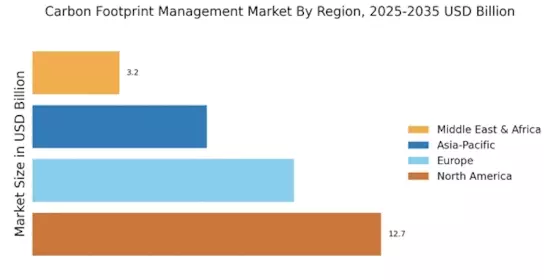Increasing Regulatory Pressures
Regulatory pressures are a pivotal driver in the Carbon Footprint Management Market, as governments worldwide are implementing stringent regulations aimed at reducing greenhouse gas emissions. Policies such as carbon pricing, emissions trading systems, and mandatory reporting requirements compel organizations to adopt comprehensive carbon management strategies. The market is witnessing a notable increase in demand for compliance solutions, with a projected market size reaching approximately $10 billion by 2026. Companies that fail to comply with these regulations may face substantial penalties, thus incentivizing investment in carbon footprint management solutions to mitigate risks and enhance sustainability practices.
Investment in Renewable Energy Sources
The transition towards renewable energy sources is a crucial driver for the Carbon Footprint Management Market. As organizations seek to reduce their carbon emissions, there is a growing investment in renewable energy technologies such as solar, wind, and bioenergy. This shift not only aids in lowering carbon footprints but also aligns with global sustainability goals. The market for renewable energy is projected to grow significantly, with estimates indicating a potential increase of over 20% in the next five years. Consequently, the integration of renewable energy solutions into carbon management strategies is likely to become a standard practice, further propelling the demand for carbon footprint management solutions.
Rising Consumer Awareness and Demand for Transparency
Consumer awareness regarding climate change and environmental issues is on the rise, significantly impacting the Carbon Footprint Management Market. As consumers become more informed, they are increasingly demanding transparency from companies regarding their carbon emissions and sustainability practices. This shift in consumer behavior is prompting businesses to adopt carbon management solutions to provide clear and accurate information about their environmental impact. Market data suggests that companies that prioritize transparency in their carbon footprint reporting are likely to gain a competitive edge, as consumers are more inclined to support brands that demonstrate a commitment to sustainability.
Corporate Social Responsibility and Sustainability Goals
The growing emphasis on corporate social responsibility (CSR) is significantly influencing the Carbon Footprint Management Market. Organizations are increasingly recognizing the importance of sustainability in their business models, driven by consumer demand for environmentally responsible practices. Many corporations are setting ambitious sustainability goals, such as achieving net-zero emissions by 2030 or 2050. This trend is expected to propel the market, as companies invest in carbon management solutions to track progress and report transparently on their environmental impact. Research indicates that firms actively engaging in sustainability initiatives can enhance their brand reputation and customer loyalty, further driving the adoption of carbon footprint management technologies.
Technological Innovations in Carbon Footprint Management
The Carbon Footprint Management Market is experiencing a surge in technological innovations that enhance the accuracy and efficiency of carbon tracking and reporting. Advanced software solutions, including AI and machine learning algorithms, are being integrated into carbon management systems, allowing organizations to analyze vast amounts of data in real-time. This technological evolution is projected to drive market growth, with estimates suggesting a compound annual growth rate of over 15% in the coming years. Furthermore, the adoption of IoT devices for monitoring emissions in various sectors, such as manufacturing and transportation, is likely to provide more granular insights into carbon footprints, thereby facilitating better decision-making and compliance with environmental standards.


















Leave a Comment